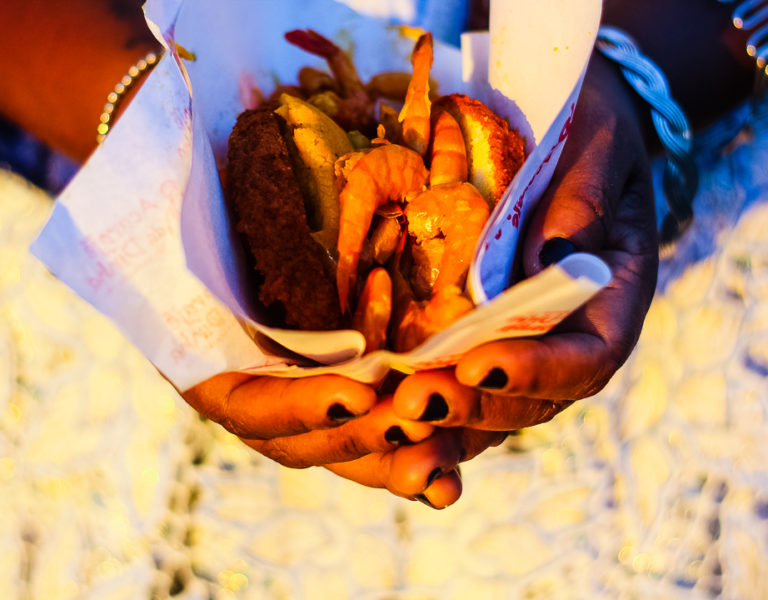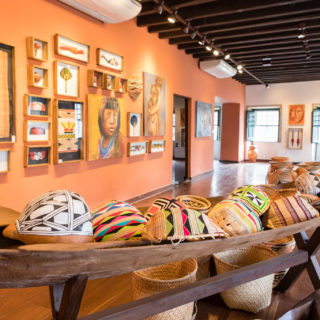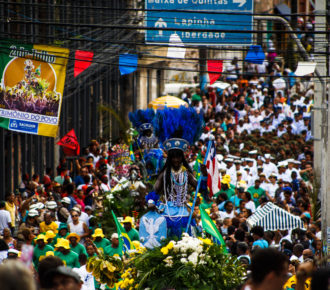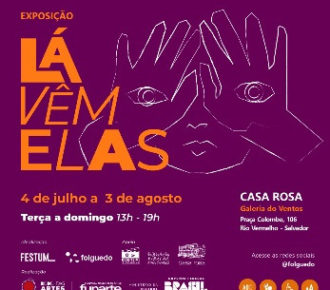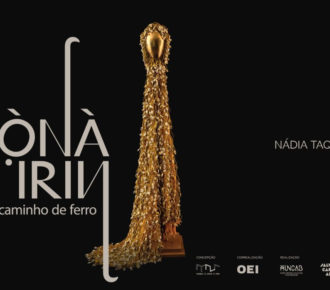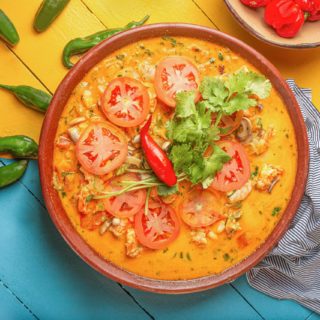
History, recipe and tradition: discover the historical value of the famous fritter in Bahian culture
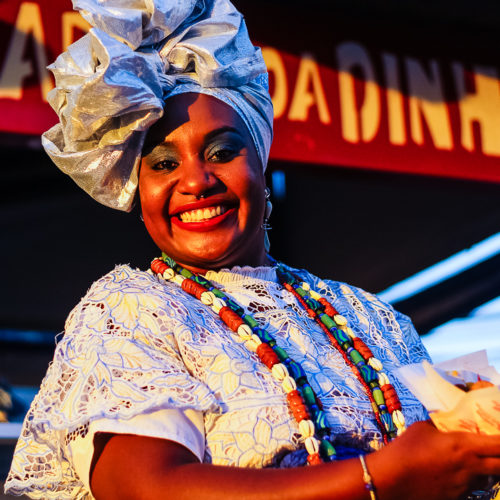
One of the great icons of Bahia, full of ancestry and practically a tourist spot in itself. Acarajé is more than food and sustenance for several families; it has an important symbolic character. Going out for an acarajé is also a good idea after a hard day at work. It is a meeting point, a meeting between friends and it’s perfect on the beach. Acarajé is affective memory.
There are many reasons for Bahians and visitors to be in love with it. Who tells us is Elaine Michele Assis Cruz, one of the people in front of Dinha’s tabuleiro (the board where acarajé is sold), in Rio Vermelho, one of the most emblematic acarajés in Salvador.
“I believe that this passion for acarajé is due to the tradition in which it is involved. It is a sacred food, of African origin with a lot of axé, tradition and flavor, in addition to its accompaniments, such as vatapá, caruru, salad, chili and shrimp, which complements it, making the fritter the flagship of Afro-Bahian cuisine, and desired by tourists.”
And do you know what acarajé is made of? Do you know the tradition? We will tell you! Visit Salvador da Bahia gathered 14 curiosities about acarajé. Come with us and see if you knew all of them.
1. It ‘s been based!
We asked Elaine Michele Assis Cruz if tourists know what acarajé is made of and if they ask about the recipe:
“Tourists generally don’t know and do ask how to prepare it and its recipe. Some even invent some ingredients (lol). But I teach what governs the tradition and some are surprised by the fact that it is a black bean fritter seasoned with onion and salt to taste”, she explains.
The ingredients
The dough takes black-eyed beans, grated onion, palm oil and salt to taste. Soak the beans for five to six hours. Then you have to peel off the beans and grind them. Each “baiana” does it in a way, some use the acarajé pestle, others use the manual mill and even electric cereal grinders. Add the onion and salt. There are those who say that “the mystery” happens at that time, when beating the dough. Remove the portion of the dough with a spoon and put it to fry in the boiling palm oil.
2. Arabic falafel
The acarajé of the West African Yoruba (Togo, Benin, Nigeria, Cameroon) is similar to the Arabian falafel which is made from a crushed and fried chickpea dough.
The acarajé from Bahia is originally from the Gulf of Benin, called acará there, having been brought to Brazil with the arrival of enslaved people from that region.
There is even a documentary series that tells the connection of the two foods. “A História da Alimentação no Brasil” (The History of Food in Brazil) has 13 episodes and is based on a book by the anthropologist potiguar Luís da Câmara Cascudo (1898-1986). The eighth episode, entitled “African Diet”, speaks of African roots in our country’s dietary customs.
Watch now on this link.
3. What does “acarajé” mean?
The word acarajé comes from the Yoruba àkàrà, “fireball”, + je, “to eat”
“Acarajé means ‘to eat fireball’. This delicacy of African origin is the symbol of our state’s culture. It’s the postcard from our city together with the baiana and her board”, says Elaine.
According to her, every tourist who comes to the city wants to try the delight. The Bahians have acarajé as a mandatory dish.
“At least once a week, you have to eat it and activate the palm oil in your blood,” she says, smiling.
4. Hot or cold
Even the chili sauce is special for acarajé, with ginger within the recipe. In the book “Cozinhando Histórias – Receitas, Histórias e Mitos de Pratos Afro-brasileiros” (Cooking Stories – Recipes, stories and Myths of Afro-Brazilian Dishes)*, the list of ingredients include: palm oil, ripe and ground hot chili, grated ginger, salt and grated onion.
Stay tuned! If someone asks you if you want a hot or cold acarajé don’t assume it’s related to the temperature. The person wants to know if you want too much or too little chili: too much (hot) or too little (cold). Almost nobody plays this game, but if they do, now you know!
5. Sacred food
Acarajé is considered a sacred food within candomblé and its recipe cannot be modified. Rita Santos, President of the Association of Baianas de Acarajé and who is in charge of the Memorial of the Baianas de Acarajé, explains:
“It all started in the symbolic. The enslaved women sold acarajé to buy manumission. In the second stage, the baianas went to the streets to sell the acarajé to do their duties at the terreiros, normally Oiá’s daughters (it couldn’t be just anyone).”
She also says that, over time, it was then realized that the person who sold the fritter could support the family. That was when the acarajé went to the streets to be sold.
“It is commercial, but, in my mind, it is still symbolic because it continues to belong to the terreiro, it remains sacred. The acarajé is an offering for Iansã and the abará is an offering for Xangô”, she concludes.
6. The Acarajé Myth
In the book “Cozinhando Histórias – Receitas, Histórias e Mitos de Pratos Afro-brasileiros”, the researcher and photographer Josmara B. Fregoneze, the specialist in Afro-Brazilian cuisine, Marlene Jesus da Costa and Dona Cici *, a griô who dedicates her time to passing on Afro-Brazilian ancestral wisdom, say that many of the Afro-Bahian dishes served today – mainly on festive occasions – and restaurants, originated from religious foundations linked to candomblé.
According to legend, every day Oxum prepared Xangô’s food and Iansã carried the pot containing the king’s secret to his palace on her head. One day, Oxum called Iansã and asked her to take the pot but not to look at what was inside. Halfway to King Xangô’s palace, curiosity was stronger and Iansã opened the lid and, very frightened, saw the flames of fire rise to a great height. Quickly, she closed the pot and continued on her way. Arriving at the palace, she knelt before Xangô and lowered the pot, looking away from the king. Xangô asked three times if she saw what the king eats. Iansã said yes. Then Xangô said: “Women who know my secret become my wives”.
7. Is there a right time to eat acarajé?
In the beginning, all the people who produced and commercialized acarajé were initiated in candomblé, in a practice restricted to women, in general “Filhas de Santo” dedicated to the cult of Xangô and Oiá (Iansã). In order to fulfill their “obligations” with the orixás, during the colonial period, the freed black women or black women of income prepared the delicacies and went out into the streets at night to sell them, giving rise to this custom. To this day, the vast majority of the baianas go to the streets only after 5 pm.
8. Knowledge passed from mother to daughter
The baiana’s selling point is licensed by the City Hall, so it cannot be sold to another person, being passed from mother to daughter. But, even before all legalization of the trade, it was a tradition to pass the board to a family member. One of the best-known baianas, Dinha do Acarajé is an example.
Elaine Michele Assis Cruz says that the board “Acarajé da Dinha” was founded in January 1944 at Largo de Santana, in Rio Vermelho, by Ubaldina de Assis, her great-grandmother. Later, she began to stay only in the kitchen and passed the throne on to her daughter Ruth de Assis (Elaine’s grandmother). With the death of Ruth, the board passed to Lindinalva and Edna de Assis, and then to Cláudia Assis, Elaine’s older sister. It is currently managed by herself and her brother, Edvaldo Cruz.
But, as every rule has its exceptions, many baianas did not have a daughter, but a son, and the children followed in the mother’s footsteps, since this is a family profession. Nowadays, it is not a rule that they are Candomblé people. The baiana may even be from another religion, as long as she respects tradition and follows the IPHAN decree, according to which the baiana must be on the street in a gown, skirt and a turban and the board must be organized.
9. What does the baiana have?
Written by Dorival Caymmi and eternalized by Carmen Miranda, “O que é que a baiana tem?” was one of the songs on the soundtrack for the 1939 film “Banana da Terra”. The Brazilian musical was the last appearance of the Portuguese singer from Brazilian soul in national cinema. If you stop to analyze, Carmen singing this song is the only scene from the film that stuck on people’s mind: or do you know several people who have seen this film at its full length?
Carmen Miranda became a style icon in the 1940s, being one of the first references in national fashion. The famous cinematographic look was all inspired by the dress code of the Candomblé terreiros celebrations in Bahia and the baianas de acarajé traditional costumes, of which item by item was in Caymmi’s lyrics.
The turban, the long round skirt, earrings and bangles became her trademark in Brazil and in the world after this appearance. If that had happened today, it would certainly have been discussed in more depth.
“…O que é que a baiana tem?
Tem torso de seda tem (tem)
Tem brinco de ouro tem (tem)
Corrente de ouro tem (tem)
Tem pano da Costa tem (tem)
Tem bata rendada tem (tem)
Pulseira de ouro tem (tem)
E tem saia engomada tem (tem)
Tem sandália enfeitada tem (tem)
E tem graça como ninguém…”
“… What does the Baiana have?
Has a silk turban has (has)
Has gold earrings has (has)
A gold chain has (has)
Has a cloth from Costa has (has)
Has a lacy gown has (has)
A gold bracelet has (has)
And has a starched skirt has (has)
Has decorated sandals has (has)
And is graceful as no one else … ”
10. Clothing and religiosity around the baiana
The baianas’ clothing, characteristic of Candomblé rites, is also a strong element of identification of this office, being composed of turbans, cloths and beaded necklaces that symbolize the religious initiation of the baianas.
The baianas’ clothing also brings together visual elements of the European Baroque through its many embroideries and lace. It is a multicultural outfit, involving several elements such as the starched cloth, the traditional richelieu, the lavender scent, the fig sign and the conch earrings. There are baianas who always wear cheetah prints, which were the clothes that the first baiana of acarajé wore.
These so-called “gala clothes” are more used in days of popular festivals, processions and in welcomings. They also get “Pano da Costa”**, and today they even added shiny cloths, in addition to traditional fig signs, long necklaces, bracelets and rings.
11. There was not always caruru and salad in acarajé
Rita Santos, President of ABAM, explains that, chronologically, at the beginning, only the “fritter” with chili was sold. Then vatapá and shrimp were added. Caruru and salad became a custom about 30 years ago. For this reason, some baianas do not sell these last two supplements, because they do not think it makes sense.
Each person has a preferred way of eating acarajé. In Elaine Michele’s opinion, “what makes acarajé perfect is good black-eyed beans, well-beaten dough and crunchiness when biting into the crust. Accompanied by a little chili and shrimp, of course”.
12. The other delicacies on the board
In the baiana board you have: acarajé, abará, vatapá, caruru, shrimp, salad and chili, in addition to the “cocada”, “bolinho de estudante” and “passarinha”. Even so, all this is at the discretion of each baiana.
“I would like to rescue other things that were on the boards, such as ‘pé de moleque’, fish, acaçá, we had grandma’s cassava flour, there were many other things on the baiana’s board in the past,” says Rita Santos.
13. The Baiana de Acarajé National Day
The Baiana de Acarajé National Day is celebrated annually on November 25. A tribute to the historical and cultural importance of the Baiana de Acarajé figure, a name given to women who are dedicated to the production and sale of this typical delicacy from Bahia.
The date symbolizes the recognition of the African ancestors’ legacy importance in the historical process of forming our society and the heritage value of a universal cultural complex. The Office of the Baianas de Acarajé is considered Brazil’s Historic and Intangible Heritage.
14. Documentary
The documentary “Àkàrà, no fogo da intolerância” (Àkàrà, in the fire of intolerance) proposes the rescue of historical events through reports by baianas de acarajé. The delicacy runs the risk of losing the title of Historic and Intangible Heritage due to the mischaracterization of its original recipe and commercialization by people of other faiths.
“Àkàrà, no fogo da intolerância” is a documentary that joins the fight against intolerance that affects mainly African religions. The film makes a historical analysis from the perspective of those who suffer this type of violence to its relationship with the structuring racism established in Brazilian society. Click on this link and watch now.
By Fernanda Slama
Content Coordinator
Note:
Book *: “Cozinhando Histórias – Receitas, Histórias e Mitos de Pratos Afro-brasileiros” with photos by Pierre Verger. Written by Josmara B. Fregoneze, Marlene Jesus da Costa and Nancy Sousa, better known as Dona Cici.
Dona Cici * – griô, Dona Cici devotes her time to passing on Afro-Brazilian ancestral wisdom. She knows a lot about the culture of the orixás and our history.
Pano da Costa ** – is an integral part of the baiana’s clothing, characteristic of the streets of Salvador and Rio de Janeiro in the 19th century. Generally rectangular, the coast cloth is traditionally white or bicolor and can be embroidered or with lace applications. The name may have derived from its origin in West Africa or from the fact that it is used preferentially thrown over the shoulders and back.

